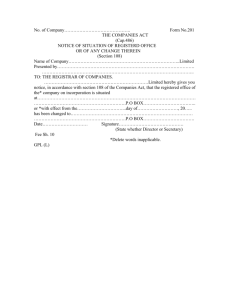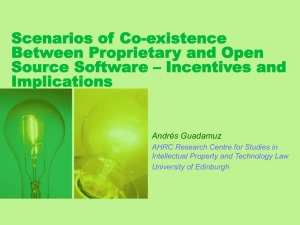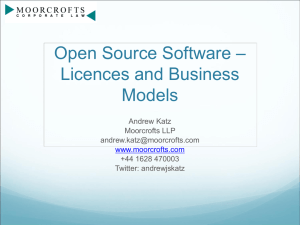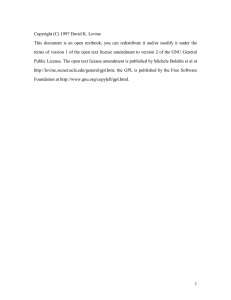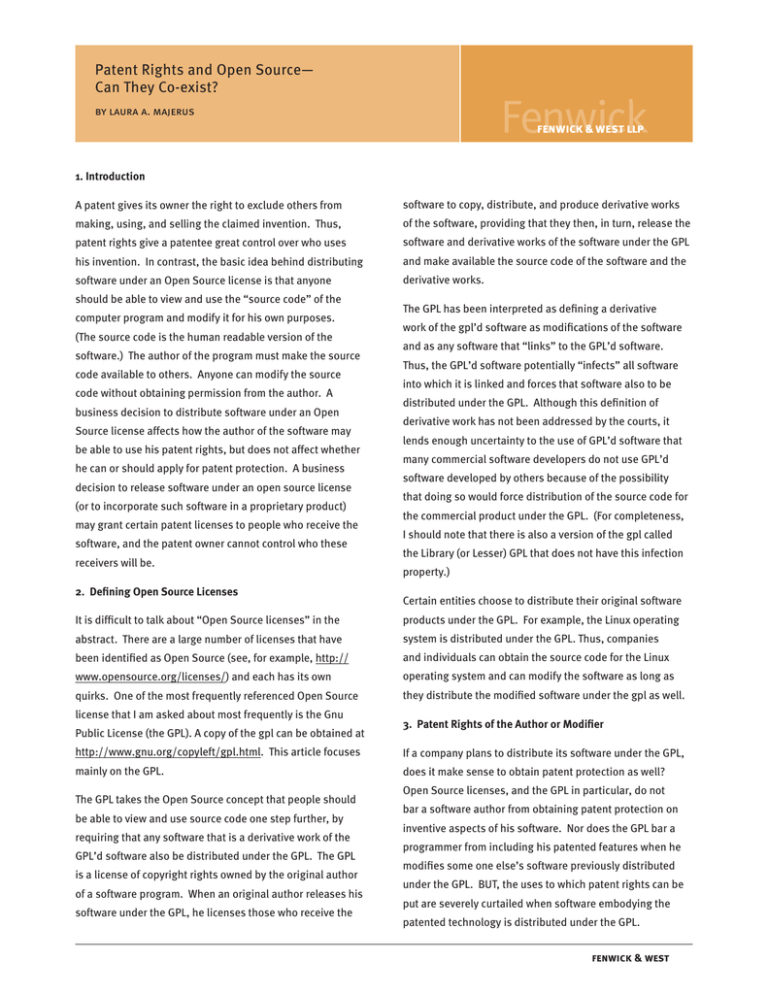
Patent Rights and Open Source—
Can They Co-exist?
by laura a. majerus
1. Introduction
A patent gives its owner the right to exclude others from
software to copy, distribute, and produce derivative works
making, using, and selling the claimed invention. Thus,
of the software, providing that they then, in turn, release the
patent rights give a patentee great control over who uses
software and derivative works of the software under the GPL
his invention. In contrast, the basic idea behind distributing
and make available the source code of the software and the
software under an Open Source license is that anyone
derivative works.
should be able to view and use the “source code” of the
computer program and modify it for his own purposes.
(The source code is the human readable version of the
software.) The author of the program must make the source
code available to others. Anyone can modify the source
code without obtaining permission from the author. A
business decision to distribute software under an Open
Source license affects how the author of the software may
be able to use his patent rights, but does not affect whether
he can or should apply for patent protection. A business
decision to release software under an open source license
(or to incorporate such software in a proprietary product)
may grant certain patent licenses to people who receive the
software, and the patent owner cannot control who these
receivers will be.
2. Defining Open Source Licenses
The GPL has been interpreted as defining a derivative
work of the gpl’d software as modifications of the software
and as any software that “links” to the GPL’d software.
Thus, the GPL’d software potentially “infects” all software
into which it is linked and forces that software also to be
distributed under the GPL. Although this definition of
derivative work has not been addressed by the courts, it
lends enough uncertainty to the use of GPL’d software that
many commercial software developers do not use GPL’d
software developed by others because of the possibility
that doing so would force distribution of the source code for
the commercial product under the GPL. (For completeness,
I should note that there is also a version of the gpl called
the Library (or Lesser) GPL that does not have this infection
property.)
Certain entities choose to distribute their original software
It is difficult to talk about “Open Source licenses” in the
products under the GPL. For example, the Linux operating
abstract. There are a large number of licenses that have
system is distributed under the GPL. Thus, companies
been identified as Open Source (see, for example, http://
and individuals can obtain the source code for the Linux
www.opensource.org/licenses/) and each has its own
operating system and can modify the software as long as
quirks. One of the most frequently referenced Open Source
they distribute the modified software under the gpl as well.
license that I am asked about most frequently is the Gnu
Public License (the GPL). A copy of the gpl can be obtained at
3. Patent Rights of the Author or Modifier
http://www.gnu.org/copyleft/gpl.html. This article focuses
If a company plans to distribute its software under the GPL,
mainly on the GPL.
does it make sense to obtain patent protection as well?
The GPL takes the Open Source concept that people should
be able to view and use source code one step further, by
requiring that any software that is a derivative work of the
GPL’d software also be distributed under the GPL. The GPL
is a license of copyright rights owned by the original author
of a software program. When an original author releases his
software under the GPL, he licenses those who receive the
Open Source licenses, and the GPL in particular, do not
bar a software author from obtaining patent protection on
inventive aspects of his software. Nor does the GPL bar a
programmer from including his patented features when he
modifies some one else’s software previously distributed
under the GPL. BUT, the uses to which patent rights can be
put are severely curtailed when software embodying the
patented technology is distributed under the GPL.
fenwick & west The Preamble of the GPL states:
“Finally, any free program is threatened constantly by
software patents. We wish to avoid the danger that
redistributors of a free program will individually obtain
patent licenses, in effect making the program proprietary. To
prevent this, we have made it clear that any patent must be
licensed for everyone’s free use or not licensed at all.”
author has not given permission for his competitor to use
the patented technology.
4. Existing Licenses
What if the original author or modifier is a patent licensee
under an existing license? For example, the original author
might have a license from a third party for an invention
included in the GPL’d software. For example, the original
It is black-letter patent law that once a patent is granted,
author may release internet software that incorporates an
a patent owner has the right to exclude other from making
encryption technology covered by a patent licensed from
using and selling his patented invention if he so chooses.
a third party. If the original author of the GPL’d internet
Setting aside any arguments that the Preamble of the GPL
software has been granted the right to sublicense, he may
is somehow not a part of the license, it seems clear that an
be able to include the patented technology in his GPL’d
author or modifier who distributes software under the gpl
software, since he can give a sublicense to this GPL’d users.
cannot assert his patent rights against subsequent users
Conversely, of course, the author cannot distribute his
and redistributors of the GPL’d software. Thus, there is
software if he cannot sublicense subsequent users. The GPL
at least an implied license to those who receive the GPL’d
addresses this issue, saying:
software in any patents covered by the software.
If you cannot distribute so as to satisfy simultaneously
Why then, would anyone want to obtain a patent on an
your obligations under this License and any other
invention that is going to be distributed under the GPL?
pertinent obligations, then as a consequence you
There are several reasons: 1) the author may plan to
may not distribute the Program at all. For example,
license the patent to others to produce a revenue stream
if a patent license would not permit royalty-free
2) the author may want to assert his patent rights against
redistribution of the Program by all those who receive
redistributors who do not conform to the GPL license terms
copies directly or indirectly through you, then the only
(for example, by failing to redistribute under the GPL) 3)
way you could satisfy both it and this License would be
the author may want to have patent rights to use as an
to refrain entirely from distribution of the Program.
offensive or defensive weapon against infringers who are
not using the GPL’d software and 4) the author may plan
to also distribute a non-GPL’d version of the software. For
example, while the author may not be able to use his patent
rights against people who receive and redistribute his
GPL’d software, the author can use these rights against his
competitor who sells a competing product that incorporates
the invention that is not a derivative work of the author’s
original code. According to one reasonable interpretation,
the GPL only precludes the patentee from asserting his
rights against people who are practicing the invention by
using his GPL’d software. People who independently create
other software are not subject to this implied license. As an
aside, it seems that the author could assert his patent rights
against a competitor who is himself releasing independently
developed software under the GPL, as long as it is not
based on the original author’s distribution. The fact that the
infringer himself distributes under the GPL is irrelevant as
to whether he is infringing patents of others. The original
2 patent rights and open source—can they co-exist?
Thus, if an author does not have the right to sublicense or
if the sublicense would require the payment of royalties,
the author must chose between not including the patented
technology or not releasing the software. Thus, companies
planning to distribute GPL’d software should consider
whether the software is subject to existing patent licenses.
If so, and if sublicensing rights cannot be obtained, the
patented technology should not be included in the GPL’d
distribution. If there are existing formal license agreements
that cover technology in software that a company plans
to distribute under the GPL, the existing license should
be carefully reviewed to determine whether the license
includes the right to sublicense. The converse, of course,
is that a patent owner who licenses to another party who
has stated its intent to distribute under the GPL should
consider whether they want to grant the right to sublicense.
In theory, there is no limit to how many other parties
will eventually receive the GPL’d software and become
sublicensees of the patent.
fenwick & west
5. What is the Limit of an Implied License under the GPL?
As discussed above, users and modifiers of GPL’d software
have at least an implied license to use patented inventions
included in the GPL’d software. The users probably do not,
however, have a blanket license to use the invention in
other circumstances. Thus, if a programmer who uses GPL’d
software develops software that uses the patented invention
without using any of the GPL’d software, he arguably does
not have a license to use the invention in this manner. If a
user copies a portion of the GPL’d software and includes it in
but it seems certain that, as more commercial entities begin
to incorporate GPL’d code into their products, it is only a
matter of time before court cases involving the GPL begin to
appear. While some of these cases will involve the copyright
law questions raised by the GPL, others will be patent cases,
where the GPL is used as a potential defense by infringers
who received GPL’d software incorporating the asserted
patent. Corporate counsel should be aware of the risks
involved in the GPL before making decisions concerning this
license.
this software, he may arguably have a license since his new
Laura Majerus is a partner at Fenwick & West LLP. If you have
software is based on gpl’d software.
any questions about this publication, please contact Laura
6. Patents in Non-U.S. Countries
Majerus at lmajerus@fenwick.com, or call at 650.335.7152.
©2006, Fenwick & West LLP. All Rights Reserved.
There is no such thing as a worldwide patent. Patents are
granted on a country-by-country basis. The GPL states:
If the distribution and/or use of the Program are restricted
in certain countries either by patents or by copyrighted
interfaces, the original copyright holder who places the
Program under this License may add an explicit geographical
distribution limitation excluding those countries, so that
distribution is permitted only in or among countries not
thus excluded. In such case, this License incorporates the
limitation as if written in the body of this License.
The GPL seems to be referring to the situation where the
patent is owned by a third party. It does not address the
possibility that a patent holder and author of the program
are the same. This assumption seems correct since, if the
patent holder and author are the same entity, the users
of the program would have an implied license to use the
patented invention and would have an implied license
to distribute and modify the software since this is the
whole purpose of the gpl. Under those circumstances, the
distribution or use would not be restricted.
7. Summary
Because there are no decided court cases interpreting the
GPL, there are business risks involved both in releasing
software under the GPL and in using software received
from others under the GPL. To date, all disputes involving
the GPL of which this author is aware have been settled
informally out of court. It remains to be seen how courts will
interpret the rather vague references to patents in the GPL,
3 patent rights and open source—can they co-exist?
fenwick & west

